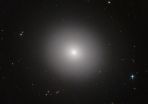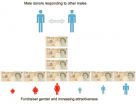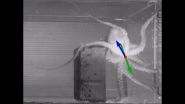(Press-News.org) Astronomers have shown for the first time how star formation in "dead" galaxies sputtered out billions of years ago. The NASA/ESA Hubble Space Telescope and ESO's Very Large Telescope (VLT) have revealed that three billion years after the Big Bang, these galaxies still made stars on their outskirts, but no longer in their interiors. The quenching of star formation seems to have started in the cores of the galaxies and then spread to the outer parts. The results will be published in the 17 April 2015 issue of the journal Science.
A major astrophysical mystery has centred on how the massive, quiescent elliptical galaxies, common in the modern Universe, quenched their once furious rates of star formation. Such colossal galaxies, often also called spheroids because of their shape, typically pack in stars ten times as densely in the central regions as in our home galaxy, the Milky Way, and have about ten times its mass.
Astronomers refer to these big galaxies as red and dead as they exhibit an ample abundance of ancient red stars, but lack young blue stars and show no evidence of new star formation. The estimated ages of the red stars suggest that their host galaxies ceased to make new stars about ten billion years ago. This shutdown began right at the peak of star formation in the Universe, when many galaxies were still giving birth to stars at a pace about twenty times faster than nowadays.
"Massive dead spheroids contain about half of all the stars that the Universe has produced during its entire life," said Sandro Tacchella of ETH Zurich in Switzerland, lead author of the article. "We cannot claim to understand how the Universe evolved and became as we see it today unless we understand how these galaxies come to be."
Tacchella and colleagues observed a total of 22 galaxies, spanning a range of masses, from an era about three billion years after the Big Bang [1]. They used the NASA/ESA Hubble Space Telescope's Wide Field Camera 3 (WFC3) to peer at the galaxies from above our planet's distorting atmosphere -- WFC3 snapped detailed images in the near-infrared, revealing the spatial distribution of older stars within the actively star-forming galaxies.
The researchers also used the SINFONI) instrument on ESO's Very Large Telescope to collect light from the galaxies, showing precisely where they were churning out new stars. SINFONI could make these detailed measurements of distant galaxies thanks to its adaptive optics system, which largely cancels out the blurring effects of Earth's atmosphere.
"Hubble was able to show us how the stars are distributed within these galaxies in amazing detail," commented Marcella Carollo, also of ETH Zurich and co-author of the study. "We were able to match this accuracy with SINFONI to find patches of star formation. Using the two telescope together, we were able to explore this population of galaxies in more detail than ever before."
According to the new data, the most massive galaxies in the sample kept up a steady production of new stars in their peripheries. In their bulging, densely packed centres, however, star formation had already stopped.
"The newly demonstrated inside-out nature of star formation shutdown in massive galaxies should shed light on the underlying mechanisms involved, which astronomers have long debated," says Alvio Renzini, Padova Observatory, of the Italian National Institute of Astrophysics.
A leading theory is that star-making materials are scattered by torrents of energy released by a galaxy's central supermassive black hole as it sloppily devours matter. Another idea is that fresh gas stops flowing into a galaxy, starving it of fuel for new stars and transforming it into a red and dead spheroid.
"There are many different theoretical suggestions for the physical mechanisms that led to the death of the massive spheroids," said co-author Natascha Förster Schreiber of the Max-Planck-Institut für extraterrestrische Physik in Garching, Germany. "Discovering that the quenching of star formation started from the centres and marched its way outwards is a very important step towards understanding how the Universe came to look like it does now."
INFORMATION:
Notes
[1] The Universe's age is about 13.8 billion years, so the galaxies studied by Tacchella and colleagues are generally seen as they were more than 10 billion years ago.
Notes for editors
The Hubble Space Telescope is a project of international cooperation between ESA and NASA.
This research was presented in a paper entitled "Evidence for mature bulges and an inside-out quenching phase 3 billion years after the Big Bang" by S. Tacchella et al., to appear in the journal Science on 17 April 2015.
The team is composed of Sandro Tacchella (ETH Zurich, Switzerland), Marcella Carollo (ETH Zurich), Alvio Renzini (Italian National Institute of Astrophysics, Padua, Italy), Natascha Förster Schreiber (Max-Planck-Institut für Extraterrestrische Physik, Garching, Germany), Philipp Lang (Max-Planck- Institut für Extraterrestrische Physik), Stijn Wuyts (Max-Planck-Institut für Extraterrestrische Physik), Giovanni Cresci (Istituto Nazionale di Astrofisica), Avishai Dekel (The Hebrew University, Israel), Reinhard Genzel (Max-Planck-Institut für extraterrestrische Physik and University of California, Berkeley, California, USA), Simon Lilly (ETH Zurich), Chiara Mancini (Italian National Institute of Astrophysics), Sarah Newman (University of California, Berkeley, California, USA), Masato Onodera (ETH Zurich), Alice Shapley (University of California, Los Angeles, USA), Linda Tacconi (Max-Planck-Institut für Extraterrestrische Physik, Garching, Germany), Joanna Woo (ETH Zurich) and Giovanni Zamorani (Italian National Institute of Astrophysics, Bologna, Italy).
More information
Science credit: NASA, ESA and M. Carollo (ETH, Switzerland)
Image credit: NASA, ESA, Judy Schmidt and J. Blakeslee (Dominion Astrophysical Observatory). Note that the image is not related to science release content.
Links
Images of Hubble - http://www.spacetelescope.org/images/archive/category/spacecraft/
Link to science paper - http://www.spacetelescope.org/static/archives/releases/science_papers/heic1508a.pdf
Contacts
Sandro Tacchella
ETH
Zurich, Switzerland
Email: sandro.tacchella@phys.ethz.ch
Marcella Carollo
ETH
Zurich, Switzerland
Email: marcella@phys.ethz.ch
Richard Hook
ESO, Public Information Officer
Garching bei München, Germany
Tel: +49 89 3200 6655
Cell: +49 151 1537 3591
Email: rhook@eso.org
Georgia Bladon
ESA/Hubble, Public Information Officer
Garching, Germany
Cell: +44 7816291261
Email: gbladon@partner.eso.org
"The answers to extinction, survival and evolution are right here in the dirt," says University of Cincinnati Quaternary science researcher Ken Tankersley, associate professor of anthropology and geology. "And we are continually surprised by what we find."
While many scientists focus on species' extinction wherever there has been rapid and profound climate change, Tankersley looks closely at why certain species survived.
For many years he has invited students and faculty from archeology and geology, and representatives from the Cincinnati Museum Center and Kentucky ...
Washington, DC--Drinking sugar-sweetened beverages can suppress the hormone cortisol and stress responses in the brain, but diet beverages sweetened with aspartame do not have the same effect, according to a new study published in the Endocrine Society's Journal of Clinical Endocrinology & Metabolism.
"This is the first evidence that high sugar - but not aspartame - consumption may relieve stress in humans," said one of the study's authors, Kevin D. Laugero, PhD, of the University of California, Davis, and the U.S. Department of Agriculture's Agricultural Research Service. ...
Washington, DC--People who have osteoporosis face a 1.76-fold higher risk of developing sudden deafness than those who do not have the bone disease, according to a new study published in the Endocrine Society's Journal of Clinical Endocrinology & Metabolism.
Osteoporosis is a progressive condition in which bones become structurally weak and are more likely to fracture or break, according to the Hormone Health Network. More than 40 million people nationwide already have osteoporosis or are at risk of developing the condition due to low bone mass, according to the National ...
This news release is available in French. Quebec City, April 16, 2015--An international study led by researchers from Université Laval and CHU de Québec-Université Laval has identified significant vascular changes in the brains of people with Huntington's disease. This breakthrough, the details of which are published in the most recent issue of Annals of Neurology, will have significant implications for our understanding of the disease and could open the door to new therapeutic targets for treating this fatal neurodegenerative condition.
Huntington's ...
If you are looking to raise money online for your favorite cause, listen up. A real-world analysis of human behavior reported in the Cell Press journal Current Biology on April 16 shows that men treat online giving as a competitive enterprise. Men will donate four times more money to an attractive female fundraiser in response to the contribution of another male.
Researchers say that they suspect this tendency is a subconscious part of human psychology that exists because it is (or was) evolutionarily beneficial to us.
"People are really generous and are right, a lot ...
The body plan of octopuses is nothing if not unique, with a sophisticated brain in a soft, bilaterally symmetrical body, encircled by eight radially symmetrical and incredibly flexible arms. Now, researchers reporting the first detailed kinematic analysis of octopus arm coordination in crawling show that the animals have a unique motor control strategy to match their "odd" form. The researchers report their findings in the Cell Press journal Current Biology on April 16.
"Octopuses use unique locomotion strategies that are different from those found in other animals," ...
Bacteria that naturally reside in the gut are important for health, but recent studies consistently show that a modern lifestyle depletes the gut's collection of microbes. How lifestyle affects the diversity of this gut "microbiome" is unclear, but an analysis of the gut microbiomes of Papua New Guinean and US residents in Cell Reports now suggests that western lifestyle may diminish the variety of bacteria in the gastrointestinal tract by limiting their ability to be transmitted among humans.
"There are several aspects of western lifestyle that have been hypothesized ...
Oral infections are the most common diseases of mankind and are also a key risk factor for heart disease, which is the leading cause of death worldwide. In a review article published in Trends in Endocrinology and Metabolism on April 16, researchers summarize the latest clinical evidence supporting a link between oral infections, which are caused by the bacteria in our mouth, and heart disease, and they emphasize the important role of inflammation in both of these conditions.
"Given the high prevalence of oral infections, any risk they contribute to future cardiovascular ...
By analyzing the activity of "GPS" neurons in mice, researchers at the Stanford University School of Medicine have discovered that the mental maps created by these cells accumulate errors, which are corrected when the animal encounters a wall.
The findings support the theory that these cells, called grid cells, use an animal's perceived speed and direction to help it navigate familiar places.
Thus, as you stumble through your pitch-black kitchen in the middle of the night for a glass of water, your body knows how many steps to take and when to turn to get to the sink. ...
Men give more money through fundraising websites after seeing that other men have donated large amounts and when the fundraiser is an attractive woman, according to new UCL and University of Bristol research.
The scientists say this response by men is unlikely to be conscious and could have an evolutionary function as theories predict that generous actions can honestly signal hidden qualities, such as wealth or desirable personality attributes, to potential partners.
Co-author Dr Nichola Raihani from UCL (Life Sciences), said: "We looked at why people behave generously ...




